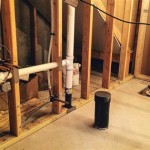What Type Of Insulation For Basement Walls
When it comes to insulating your basement walls, there are a few different types of insulation that you can choose from. The type of insulation that you choose will depend on a number of factors, including the climate in your area, the size of your basement, and your budget.
One of the most common types of insulation for basement walls is fiberglass batts. Fiberglass batts are made of fiberglass fibers that are held together by a binder. They are relatively inexpensive and easy to install, making them a good choice for DIYers. However, fiberglass batts are not as effective as some other types of insulation, and they can be susceptible to moisture damage.
Another type of insulation for basement walls is spray foam insulation. Spray foam insulation is made of polyurethane foam that is applied to the walls in a liquid form. It expands to fill all of the cracks and crevices in the walls, creating a tight seal that prevents air and moisture from entering. Spray foam insulation is very effective, but it is also more expensive than other types of insulation.
A third type of insulation for basement walls is rigid foam insulation. Rigid foam insulation is made of polystyrene or polyurethane foam that is cut into boards or sheets. It is more expensive than fiberglass batts, but it is also more effective. Rigid foam insulation is also moisture-resistant, making it a good choice for basements that are prone to flooding.
When choosing insulation for your basement walls, it is important to consider the climate in your area. If you live in a cold climate, you will need to choose an insulation that has a high R-value. The R-value of an insulation measures its resistance to heat flow. The higher the R-value, the more effective the insulation will be at preventing heat loss.
You should also consider the size of your basement when choosing insulation. If you have a large basement, you will need to choose an insulation that is thick enough to provide adequate coverage. You should also consider the cost of the insulation when making your decision. Some types of insulation are more expensive than others, so it is important to shop around and compare prices before making a purchase.
Once you have chosen the type of insulation that you want to use, you will need to install it according to the manufacturer's instructions. It is important to make sure that the insulation is installed correctly in order to ensure that it is effective. If you are not sure how to install the insulation yourself, you can hire a professional to do it for you.
Insulating your basement walls is a great way to improve the comfort and energy efficiency of your home. By choosing the right type of insulation and installing it correctly, you can help to keep your basement warm and dry all year long.

How To Insulate A Basement Wall Greenbuildingadvisor

Three Ways To Insulate A Basement Wall Fine Homebuilding

Insulating Basement Walls With Fiberglass Batting Semigloss Design

How To Insulate Basement Walls True Value

Insulating Basement Walls With Fiberglass Batting Semigloss Design

Basement Wall Insulation Knauf

How To Insulate Your Basement Like A Pro

Insulation 101 Basics Scott Mcgillivray

Healthy Basement Insulation Systems Quality Built Basements Llc

Insulating Basement Walls With Fiberglass Batting Semigloss Design








